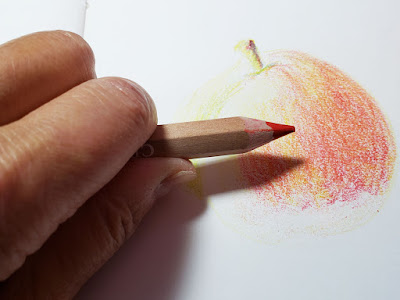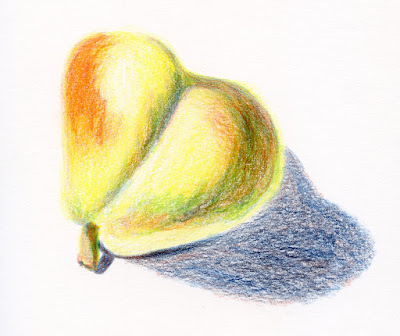 |
| 11/20/19 Cretacolor Mega Color Pencils in Stillman & Birn Epsilon sketchbook |
While
I’m in the act of sketching, especially on location, I’m not much aware of my
physical actions – my full attention is on whatever I’m drawing and how I
render it. But one day recently when I was covering a large area of the page heavily
with pigment (the foliage and shadows in this sketch), I became aware of
how I had changed the grip on my pencils as I colored. I’ve seen instructions in
drawing books about various grips, but it’s not the kind of thing I remember or
think about when I’m actually drawing. For me, the changes are mostly
intuitive.
Out
of curiosity, I started paying closer attention to how I hold pencils at
life-drawing sessions, and I realize I change the grip frequently, depending on
the task. To quickly block in a shape while measuring, I hold the pencil fairly
loosely. While I’m drawing the main contour lines and small details, I hold it
more conventionally as I would if I were writing (fingers close to the point
and the back end of the pencil supported by the crook between the thumb and
forefinger). And when I’m shading large and even relatively small areas, I hold
the pencil as if it were a piece of chalk or charcoal (the pencil inside my
fist, shown below).
 |
| The "crayon grip" |
I
became especially intrigued by this latter grip – the way a young child holds a
thick crayon – because I use it to cover a lot of ground expeditiously. I don’t
like to waste life-drawing time doing any navel- (or hand-) gazing, but later
at home, I decided to try sketching a pear entirely while using this “crayon
grip.” Remembering that I had some Cretacolor Mega jumbo-sized colored pencils that are probably intended for children, I figured these chunky
pencils would prompt me to maintain that grip.
As
expected, the crayon grip is useful for applying lots of pigment quickly when
fine details are not needed, but I was able to easily draw the contour of this
simple shape, too. I switched to my conventional writing grip only for the
stem, its shadow and the slivers of the darkest cast shadows under the pear.
The crayon grip was especially useful when loosely hatching the large cast
shadow. I didn’t have to watch myself to make sure I kept using the crayon grip;
it does feel intuitive to me.
(By
the way, in case you’re wondering: Except for doing an exercise like this, I
don’t recommend these pencils. They contain more binder than pigment, so after
a layer or two is applied, the pigment starts to slide around on the waxy
surface below, causing the dark chunks and blobs you can see on the right side
of the pear instead of blending with the previous layers.)
 |
| 11/20/19 Luminance pencils in S&B Epsilon sketchbook |
Next
I tried using much more highly pigmented Caran d’Ache Luminance pencils,
which are the same diameter as Caran d’Ache Museum Aquarelle pencils; both
are just a smidge wider than conventional pencils. (I chose the same pear but
at a different angle so that its unusually pronounced cleavage would be more apparent; maybe
it’s part peach?) Obviously, I had caught myself using the crayon grip during
life drawing with conventional sized pencils and on location while using Museum
Aquarelle pencils, so I didn’t think the barrel size would matter, and it
didn’t. However, the softness of the core does make a difference. With softer
Luminance pencils, it was much easier to use the side of the core with the
crayon grip and lay down lots of pigment quickly. In other words, the crayon
grip works best with crayon-like pencils. And of course, generous pigment also
makes a difference for the obvious reasons that it is applied quickly and blends
more easily.
I’ve
known for a long time that one reason Museum Aquarelle is my favorite on
location is that it is the softest watercolor pencil I’ve used and is therefore
very easy to apply quickly when I need to. While I prefer harder pencils for
certain applications, softer ones serve me better when speed is important. That’s
also one reason why Derwent Drawing Pencils are my favorite at life
drawing.
I
seem to have tapped into my inner crayon-using, 2-year-old self.

















































